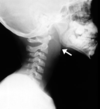Pharynx - SRS Flashcards
What is the span of the pharynx?
Basilar occiput to inferior border of CV6 and cricoid cartilage
What communications does the pharynx possess?
(passages to other spaces)
- Nasal cavities (2)
- Tympanic cavities (2)
- Oral cavity
- Larynx
- Esophagus
Where is the nasopharynx in relation to the nasal cavities? To the vertebral level?
Posterior to nasal cavities
Anterior to CV1 and CV2
Where is the oropharynx relative to the oral cavity?
To the vertebral level?
``Posterior to oral cavity
Anterior to CV3
Where is the laryngopharynx relative to the larynx?
Relative to vertebral level?
Posterior to larynx
Anterior to CV4 - CV5
Where does the pharynx become continuous with the esophagus?
CV6
What is the function of the pharynx?
Connects oral and nasal cavities to the larynx for passage of air to the lungs.
Connects oral cavity to the esophagus for passage of food and liquid to the stomach.
What are the three divisions of the pharynx?
Nasopharynx – posterior to nasal cavities
Oropharynx – posterior to oral cavity
Laryngopharynx – posterior to larynx
What are the internal features of the nasopharynx?
(6)
- Pharyngeal recess
- pharyngeal tonsil
- tubal tonsil
- torus tubarius
- Salpingopharyngeal fold
- Levator pad
Where is the pharyngeal recess?
Posterior superior wall of nasopharynx
Where is the pharyngeal tonsil located?
Pharyngeal recess
What are adenoids?
What complications can arise due to this?
Enlarged inflamed pharyngeal tonsils.
- Can obstruct nasopharynx, making breathing difficult.
- Infection can spread to tubal tonsils, blocking the auditory tube and impairing hearing.
- Infection can spread to middle ear via auditory tube.
If an infection spreads to the middle ear, what is this called?
Otitis media
Where is the tubal tonsil located?
Near the opening of the auditory tube
The torus tubarius is a mucosal prominence formed by cartilage of the auditory tube. What is the opening below this structure?
Opening of the auditory tube
The salpingopharyngeal fold is a fold of mucosa overlying the salpingopharyngeus muscle. What is the action and innervation of the salpingopharyngeus muscle?
- Assists other pharyngeal muscles during swallowing.
- Vagus nerve
Where is the levator pad located?
What is it?
Below torus tubarius
Is a fold of mucosa overlying levator veli palatini.
The Levator pad is a fold of mucosa overlying what muscle?
Levator Veli Palatini
What are the important components of the oropharynx?
- Fauces
- Faucial pillars
- palatoglossal arch
- palatopharyngeal arch
- tonsillar bed/fossa
- palatine tonsil
- epiglottic valleculae
What are the fauces?
Passageway from mouth to oropharynx
What comprise the faucial pillars?
Palatoglossal and palatopharyngeal folds
The palatoglossal arch is a fold of mucosa overlying what muscle?
Palatoglossus muscle
What is the function of the palatoglossus muscle?
Innervation?
Pulls tongue and soft palate together during swallowing.
Vagus n.
The palatopharyngeal arch is a fold of mucosa overlying what structure?
Palatopharyngeus muscle



